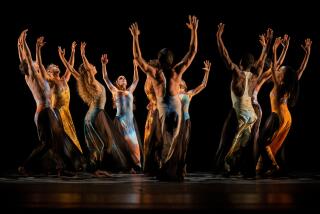Sophie Maslow, 95; She Celebrated the Working Class Through Dance
Sophie Maslow, who began her career in modern dance as a member of the Martha Graham Dance Company and went on to choreograph her own works, many inspired by folk songs and poems that uphold the dignity of ordinary people, has died. She was 95.
Maslow died June 25 in New York City, her friend and colleague Donald McKayle said last week. In recent years she had been in failing health.
“Sophie was a force in modern dance,” said McKayle, professor of dance at UC Irvine. As a choreographer, “her interest was the common man,” he said.
Early in her career, Maslow considered dance a vehicle for social change and created works about the Great Depression, the rise of labor unions and other historic events of her time. “The Dust Bowl Ballads” (1941), set to songs by Woody Guthrie, is one of her best-known works. “May Day March” and “Two Songs About Lenin,” both from the 1930s, relate to the working class.
One of her most ambitious dances, “Folksay” (1942), is set to songs by Guthrie and the poetry of Carl Sandburg. For the premiere, a performer recited lines from Sandburg’s “The People, Yes,” and Guthrie himself played guitar from the side of the stage.
The daughter of Russian Jewish immigrants, Maslow explored her cultural roots in several of her dances. “The Village I Knew” (1950) is based on short stories by Sholom Aleichem, who wrote with humor about daily life in his native Russia and the plight of Jewish immigrants in the United States.
Born in New York City on March 22, 1911, Maslow studied dance with Graham at the Neighborhood Playhouse there and joined Graham’s company in 1931. A spirited dancer, she performed solo roles in a number of Graham’s productions including “Deaths and Entrances,” based on the lives of the Bronte sisters, the 19th century English novelists.
She remained a member of the company for nine years. During that time she also choreographed works for the New Dance Group, formed in 1932 to address issues related to the Great Depression.
“Sophie made dances for the masses, in a very personal statement,” said Rick Schussel, artistic director of the New Dance Group Arts Center, an outgrowth of the original group. “She choreographed sociopolitical dance, making a statement about what people are really thinking about.”
After leaving Graham’s company, Maslow and two other dancers, Jane Dudley and William Bales, formed a trio. When they disbanded in 1952, she launched the Sophie Maslow Dance Company.
Several of her major dances have been revived in recent years. She and McKayle re-created “The Village I Knew” in 1992, performed by UC Irvine dance students.
The Limon Dance Company in New York City reconstructed Maslow’s “Champion” in 1999, based on a story about a prizefighter written by Ring Lardner, who was known for his satires on the sports world. To re-create the dance, Maslow and McKayle, a former member of her company, relied on memory and the few existing photographs of the work.
Later in her career, Maslow choreographed works set to the poetry of Lawrence Ferlinghetti and the music of Duke Ellington. She also created dances for theater productions including “The Big Winner” (1974), based on a story by Aleichem about a poor tailor who wins a lottery.
Maslow was married to Max Blatt, an artist and teacher who preceded her in death. She is survived by their daughter, Abigail Blatt.
More to Read
The biggest entertainment stories
Get our big stories about Hollywood, film, television, music, arts, culture and more right in your inbox as soon as they publish.
You may occasionally receive promotional content from the Los Angeles Times.










